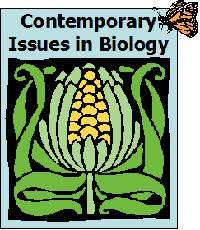
Week 6, Chapter 13 -- Adopt-a-Species Sample Assignment
Course home | Weekly schedule | Announcements | Instructor Info | Desire2Learn | MasteringBiology® | Honor Code | FAQs | HELP!
 |
Week 6, Chapter 13 -- Adopt-a-Species Sample AssignmentCourse home | Weekly schedule | Announcements | Instructor Info | Desire2Learn | MasteringBiology® | Honor Code | FAQs | HELP! |
Hello, and welcome to Learning About Snails, an exclusive presentation of TMN (The Mollusk Network). I’m Denny Gastropoda, and it is my distinct pleasure to introduce you to the topic of today’s show: the diminutive Kanab ambersnail, known to scientists as Oxyloma haydeni kanabensis.
Like all snails, the Kanab ambersnail is a mollusk. Mollusks form a diverse group of invertebrate animals that also includes clams, oysters, and squids, and octopi. Since it is an animal, biologists classify the snail in kingdom Animalia and domain Eukarya.
The habitat requirements of this lovely amber-colored snail are astonishingly specific. It occurs only at wetlands that form at the bases of limestone cliffs in two U.S. counties -- one in Arizona, and one in Utah. Barely the size of a dime, the Kanab ambersnail lives a quiet, terrestrial life in the plants that grow along the edges of wetlands.
Although it is difficult to determine precisely what this rare snail eats in its cozy wetland habitat, most other snails eat plants or algae. Therefore, the Kanab ambersnail probably lives its life grazing quietly on its photosynthetic neighbors.
Bioprospectors -- people who hunt for new uses of organisms -- have so far overlooked the Kanab ambersnail. However, marine mollusks called cone snails produce powerful toxins that pharmaceutical companies may one day develop into drugs to fight epilepsy and other diseases. Perhaps the Kanab ambersnail possesses a chemical arsenal of its own.
Sadly, this tiny but charming animal has been on the endangered species list since 1991. Part of the problem is habitat loss -- livestock trample their wetlands, and dams release water and silt that submerge the snails’ home plants. Since the Kanab ambersnail has such a severely limited range, even a relatively small habitat loss can have a devastating effect on its population.
Likewise, global climate change may also take its toll on the Kanab ambersnail. One of the main consequences of global climate change is likely to be altered rainfall patterns across the globe. The snail lives in such a specialized habitat that it is very unlikely to have any options if its wetlands dry up. Even if new wetlands develop elsewhere, how would the snail get there? It would probably go extinct.
Now that you know a little bit about the Kanab ambersnail, you may be scratching your head and asking yourself: why did I choose to profile an animal that nobody has ever heard of? To me, the answer is simple: the smallest, humblest creatures play the biggest role in life on Earth. When these unsung heroes approach extinction, we lose one more tiny twig in the massive tree of life. We cannot save these tiny twigs unless we publicize their plight.
And that’s all for this episode of Learning About Snails.
Anonymous. Posting date unknown. How Snails Feed. http://www.zephyrus.co.uk/howsnailsfeed.html. Downloaded on May 18, 2004.
U.S. Fish and Wildlife Service, Arizona Ecological Services Field Office. 2003. Kanab Ambersnail. http://arizonaes.fws.gov/kanab.htm. Downloaded on May 18, 2004.
U.S. Fish and Wildlife Service, Arizona Ecological Services Field Office. 2001. Kanab Ambersnail. http://arizonaes.fws.gov/Documents/Redbook/Kanab%20Ambersnail%20RB.pdf. Downloaded on May 18, 2004.
Zapp Machalek, Alisa. 2002. Secrets of the Killer Snails.
http://www.nigms.nih.gov/news/findings/sept02/snails.html. Downloaded on May 18, 2004.
Potential image source: http://www.nps.gov/grca/naturescience/images/kas.jpg